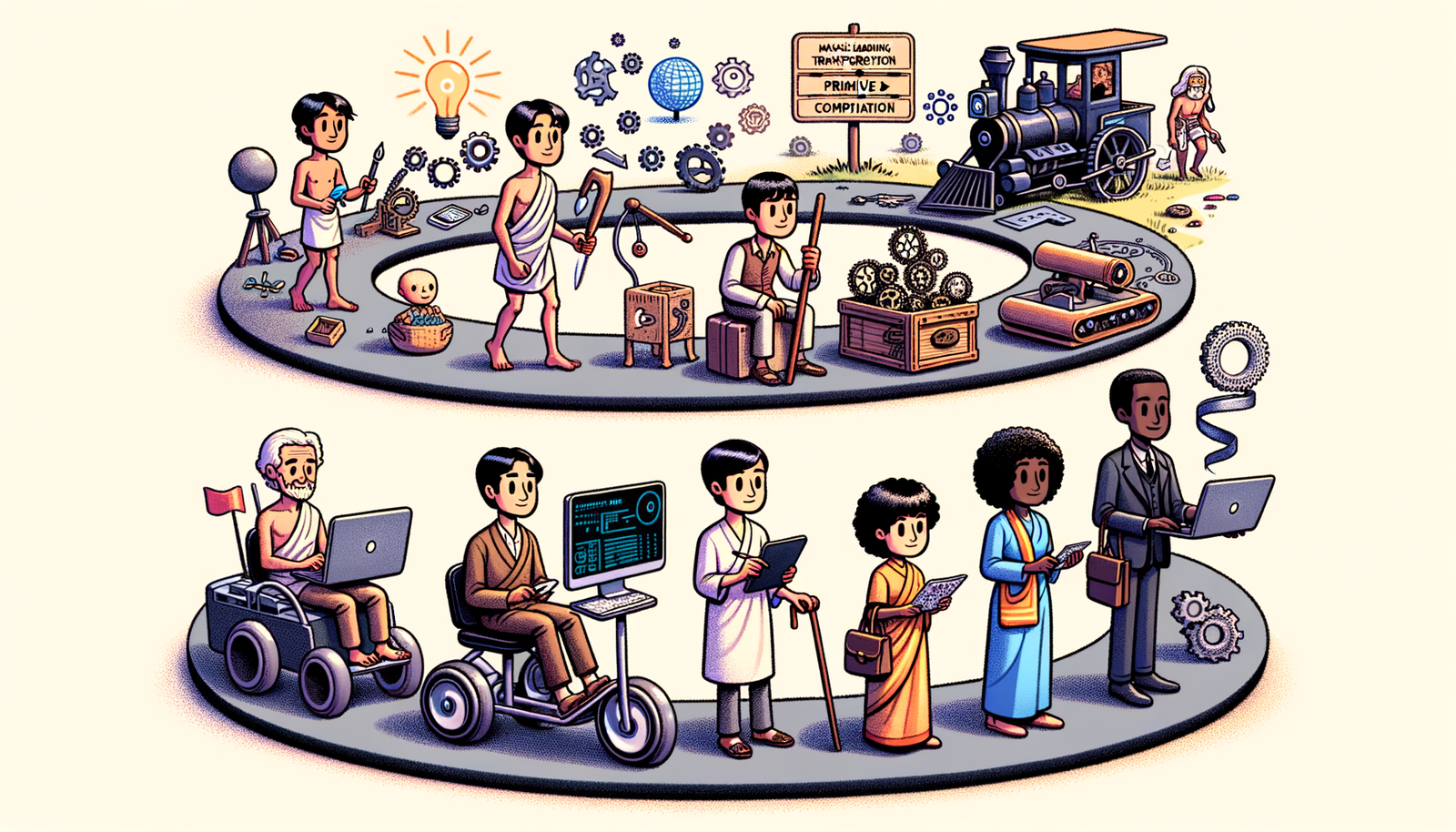Your Cart is Empty
Customer Testimonials
-
"Great customer service. The folks at Novedge were super helpful in navigating a somewhat complicated order including software upgrades and serial numbers in various stages of inactivity. They were friendly and helpful throughout the process.."
Ruben Ruckmark
"Quick & very helpful. We have been using Novedge for years and are very happy with their quick service when we need to make a purchase and excellent support resolving any issues."
Will Woodson
"Scott is the best. He reminds me about subscriptions dates, guides me in the correct direction for updates. He always responds promptly to me. He is literally the reason I continue to work with Novedge and will do so in the future."
Edward Mchugh
"Calvin Lok is “the man”. After my purchase of Sketchup 2021, he called me and provided step-by-step instructions to ease me through difficulties I was having with the setup of my new software."
Mike Borzage
Design Software History: Machine Learning Transformations in Design Optimization: A Historical Perspective
August 30, 2024 6 min read


Introduction to Machine Learning in Design Optimization
Setting the Stage
Design optimization has always been a critical aspect of engineering and architecture, seeking the best possible solutions to complex problems using constrained resources. Traditionally, this process has relied heavily on the expertise and intuition of designers and engineers, supported by advanced computational tools. However, the landscape is rapidly changing with the advent of machine learning (ML), which is introducing new capabilities and efficiencies into the design process.
Machine learning, a subset of artificial intelligence (AI), involves training algorithms on vast datasets to identify patterns and make predictions or decisions without explicit programming. The role of ML in design optimization includes enhancing the precision, speed, and scope of design tasks. It is reshaping traditional design paradigms by automating routine tasks, uncovering hidden design opportunities, and providing designers with powerful new tools for innovation and problem-solving.
As we delve into the history and impact of ML in design optimization, we will explore how this technology is transforming various industries, from automotive to architecture, and consider the future possibilities it holds.
Historical Context and Early Innovations
Beginnings of Machine Learning in Design
The integration of ML with design software began to take shape in the late 20th century, driven by advancements in both computational power and data science. Early attempts often focused on specific, well-defined problems where ML could be applied to optimize performance. Some of the first successes in this area were in fields like structural engineering and aerodynamics, where the benefits of precise optimization are most evident.
One of the earliest pioneers in integrating ML with design software was John Holland, who developed genetic algorithms (GAs) in the 1960s. GAs are inspired by the process of natural selection and have been widely used for optimization tasks. Another key figure was Geoffrey Hinton, who made significant contributions to neural networks, which are now foundational to many ML applications in design.
Companies such as Autodesk and Siemens PLM Software have been at the forefront of incorporating ML into their design tools. Autodesk's Generative Design platform, for instance, uses ML algorithms to explore a vast array of design alternatives quickly, helping designers find optimal solutions that might not be immediately apparent through traditional methods. Similarly, Siemens' NX software integrates ML to enhance various aspects of computer-aided design (CAD) and computer-aided engineering (CAE).
Milestones in the evolution of ML-driven design optimization include the development of reinforcement learning algorithms, which allow systems to learn optimal strategies through trial and error. This approach has been particularly influential in areas such as robotics and automated manufacturing, where it enables machines to adapt to changing conditions and improve their performance over time.
Landmark Projects and Implementations
Throughout the history of ML in design optimization, several landmark projects stand out for their innovative use of technology and their impact on the industry. These projects often served as proof of concept for the broader application of ML in design, demonstrating the tangible benefits that could be achieved.
One of the early examples is the use of ML in the optimization of aircraft wing designs. By employing neural networks and genetic algorithms, engineers were able to significantly improve the aerodynamic performance of wings, leading to more efficient and environmentally friendly aircraft. This success paved the way for further applications in the aerospace industry, where ML is now used in everything from materials selection to flight path optimization.
Another notable implementation is in the automotive industry, where companies like Tesla and BMW have utilized ML for vehicle design and manufacturing. By leveraging ML algorithms, these companies can optimize the structural integrity, safety, and performance of their vehicles while reducing production costs and time. This has led to more innovative and competitive products in the market.
Core Technologies and Algorithms
Key Algorithms and Techniques
The application of ML in design optimization relies on several key algorithms and techniques that have been developed and refined over the years. Among the most important are:
- Neural Networks: These are computational models inspired by the human brain, capable of recognizing patterns and making predictions. They are particularly useful in design optimization for tasks such as image recognition, material property prediction, and structural analysis.
- Genetic Algorithms (GAs): Based on the principles of natural selection, GAs are used to find optimal solutions by iteratively evolving a population of candidate solutions. They are widely used in engineering design for tasks like topology optimization and parameter tuning.
- Reinforcement Learning (RL): This approach involves training agents to make decisions by rewarding them for desirable actions and penalizing them for undesirable ones. RL has been applied in areas like robotics and automated manufacturing, where it helps systems learn and adapt to complex environments.
Each of these algorithms functions differently within design software, but they all contribute to the overarching goal of optimizing design processes. Neural networks, for example, can be used to predict the performance of different design configurations based on historical data, allowing designers to focus on the most promising options. Genetic algorithms can search through a vast space of possible designs to identify those that meet specific criteria, while reinforcement learning can help automated systems improve their performance through continuous learning.
Technological Advancements
The integration of ML in design optimization has been greatly facilitated by advancements in computational power and data storage. The increasing availability of high-performance computing (HPC) and cloud-based resources has enabled the processing of large datasets and the running of complex algorithms that were previously infeasible.
Software developments have also played a crucial role. Modern design software often includes built-in ML capabilities, allowing users to leverage advanced algorithms without needing extensive programming knowledge. Hardware advancements, such as the development of powerful graphics processing units (GPUs) and tensor processing units (TPUs), have further accelerated the adoption of ML by providing the necessary computational power for training large models.
Current and Future Impacts
Modern Applications and Success Stories
Today, the application of ML in design optimization spans a wide range of industries, each benefiting from the enhanced capabilities and efficiencies that ML offers.
In the automotive industry, for example, ML is used to optimize various aspects of vehicle design, from aerodynamics to crash safety. Companies like Tesla and BMW use ML algorithms to improve the performance and safety of their vehicles, resulting in more innovative and competitive products.
In the aerospace industry, ML is used for optimizing aircraft designs, improving fuel efficiency, and reducing environmental impact. Techniques like neural networks and genetic algorithms help engineers develop more efficient and sustainable aircraft, contributing to the industry's overall innovation.
The architecture and construction industries have also embraced ML for tasks like structural analysis, materials selection, and energy efficiency optimization. By leveraging ML, architects and engineers can create more sustainable and resilient buildings, enhancing the built environment.
These contemporary examples demonstrate the significant improvements in efficiency, cost reduction, and innovation that ML brings to design optimization. As the technology continues to evolve, its impact is expected to grow even further, transforming the way we approach design and engineering challenges.
Future Trends and Potential
Looking to the future, several trends and potential advancements are likely to shape the continued integration of ML in design optimization. These include:
- Advancements in Algorithm Development: Ongoing research in ML algorithms is expected to yield new techniques and improvements that will further enhance design optimization. For example, advancements in deep learning and generative models could lead to even more powerful design tools.
- Increased Accessibility and Usability: As ML tools become more user-friendly, a wider range of designers and engineers will be able to leverage their capabilities. This democratization of technology will enable more innovation and creativity in design processes.
- Integration with Emerging Technologies: The convergence of ML with other emerging technologies, such as the Internet of Things (IoT) and additive manufacturing, will create new opportunities for optimizing complex systems and processes.
However, there are also challenges to address, such as the need for robust data management and the ethical implications of automated design decisions. Researchers and practitioners will need to work together to overcome these hurdles and fully realize the transformative potential of ML in design optimization.
In conclusion, the integration of machine learning in design optimization represents a significant advancement in the field. By enhancing the precision, speed, and scope of design tasks, ML is transforming traditional design paradigms and opening up new possibilities for innovation and efficiency. As we continue to explore and develop this technology, its impact on the design and engineering industries is likely to be profound and far-reaching.
Also in Design News

Cinema 4D Tip: Best Practices for Twist and Bend Deformers in Cinema 4D
November 19, 2025 2 min read
Read More
AutoCAD Tip: AutoCAD Keyboard Shortcuts and Alias Configuration
November 19, 2025 2 min read
Read More
V-Ray Tip: V-Ray Bucket Rendering for Predictable Memory and Stable Farm Performance
November 19, 2025 2 min read
Read MoreSubscribe
Sign up to get the latest on sales, new releases and more …


